(精心整理)非谓语动词用法总结
- 格式:doc
- 大小:113.50 KB
- 文档页数:73

非谓语动词的用法总结非谓语动词是汉语中一种特殊的动词形式,它不具备人称和数的特征,并不直接表达动作的主体,而是依附于其他句子成分,用来修饰名词、动词、形容词或整个句子。
非谓语动词包括了不定式、动名词和分词三种形式。
今天我们就来总结一下它们的用法。
一、不定式(infinitive)是一种基本的非谓语动词形式,它的形态是“to + 动词原形”。
不定式可以作主语、宾语、定语、表语、同位语等。
例如:1. 作主语:To learn a new language is never too late.学一门新语言永远都不会太晚。
2. 作宾语:I want to visit Paris in the spring.我想在春天去巴黎旅游。
3. 作定语:The best way to improve your English is to practice every day.提高英语的最好方法就是每天练习。
4. 作表语:His dream is to become a famous musician.他的梦想是成为一名著名的音乐家。
5. 作同位语:Her wish is for everyone to be happy.她的愿望是每个人都快乐。
二、动名词(gerund)是名词化的动词,它的形态是动词的现在分词形式(V-ing),可以作主语、宾语、定语、表语等。
例如:1. 作主语:Swimming is good for your health.游泳对身体健康有好处。
2. 作宾语:He enjoys playing basketball in his free time.他喜欢在空闲时间打篮球。
3. 作定语:I have a meeting with my boss this afternoon.我今天下午有个与老板的会议。
4. 作表语:Her favorite activity is dancing.她最喜欢的活动是跳舞。

千里之行,始于足下。
英语非谓语动词用法总结非谓语动词是英语中一种特殊的动词形式,它们没有主语,也没有时态的变化。
非谓语动词分为不定式、分词和动名词三种形式。
它们在句子中可以充当动词、形容词或名词的作用,用来修饰或补充主句的内容。
非谓语动词用法灵活多样,可以用在主句的前面、后面或中间位置,并且可以与其他成分同时存在于一个句子中。
在本文中,我将总结非谓语动词的用法,并给出一些例子来帮助理解。
一、不定式(infinitive)1. 不定式作主语e.g. To learn English is my goal. 学英语是我的目标。
2. 不定式作宾语a) 动词后直接接不定式作宾语e.g. I want to go to the cinema. 我想去电影院。
b) 动词后接代词(宾格)+不定式作宾语e.g. She advised me not to buy that car. 她建议我不要买那辆车。
3. 不定式作宾语补足语e.g. I found it hard to understand his accent. 我发现很难理解他的口音。
4. 不定式用来表示目的e.g. I went to the library to borrow some books. 我去图书馆借书。
5. 不定式用来表示结果第1页/共3页锲而不舍,金石可镂。
e.g. She was too tired to continue working. 她太累了,无法继续工作。
6. 不定式用来表示原因e.g. He called me to apologize. 他打电话给我道歉。
7. 不定式用来表示方式e.g. She danced gracefully to the music. 她优雅地随着音乐跳舞。
二、分词(participle)1. 现在分词(-ing形式)a) 分词作定语,修饰名词e.g. The running dog is mine. 那只奔跑的狗是我的。

非谓语动词的用法总结动词不定式(一) 时态1. 一般式动词不定式的一般式表示与谓语动词同时或之后的行为。
如: I want to have a restI plan to attend the meeting 2. 完成式不定式的完成式表示不定式的动作发生在谓语动词所表示的动作之前的行为。
如:I ’m sorry to have kept you waiting. 3进展式不定式的动作假如同谓语动词所表示的动作同时发生那么使用不定式的进展式。
如: They seemed to be talking about something important. 4. 完成进展式不定式的完成进展式表示在谓语动词之前已经发生,并且一直进展着的动作。
如: He is said to have been working in that factory for twelve years. 〔二〕动词不定式用法:1. 作主语To master English gives us much help in the study of science 2. 作宾语I want to leave here soon. He pretended to be a doctor. 3. 作表语The most important thing is to study hard. 4. 作宾语补足语不定式作定语必须放在被修饰的名词或代词的后面。
I have no time to talk with her. 6. 作状语不定式作状语时可以表示目的、原因、结果或条件。
I came here to learn from you ( 目的) I ’m very glad to heard the news。
〔原因〕 He is old enough to go to school.(结果) To look at him ,you can’t help laughing.Notes:7. 不定式的复合构造。
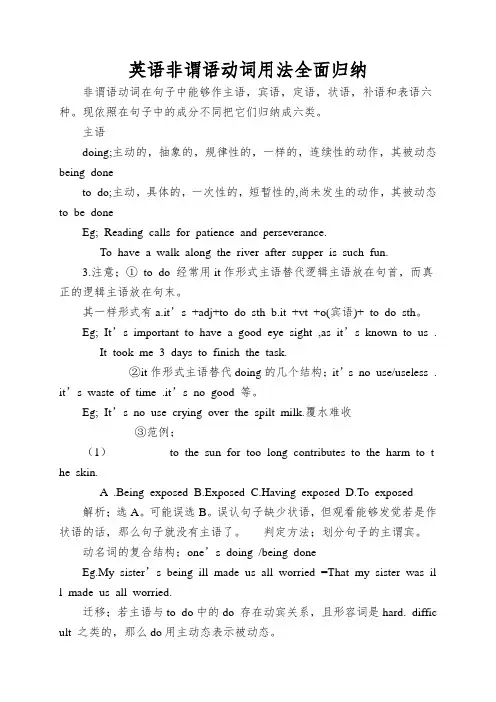
英语非谓语动词用法全面归纳非谓语动词在句子中能够作主语,宾语,定语,状语,补语和表语六种。
现依照在句子中的成分不同把它们归纳成六类。
主语doing;主动的,抽象的,规律性的,一样的,连续性的动作,其被动态being doneto do;主动,具体的,一次性的,短暂性的,尚未发生的动作,其被动态to be doneEg; Reading calls for patience and perseverance.To have a walk along the river after supper is such fun.3.注意;①to do 经常用it作形式主语替代逻辑主语放在句首,而真正的逻辑主语放在句末。
其一样形式有a.it’s +adj+to do sth b.it +vt +o(宾语)+ to do sth。
Eg; It’s important to have a good eye sight ,as it’s known to us .It took me 3 days to finish the task.②it作形式主语替代doing的几个结构;it’s no use/useless . it’s waste of time .it’s no good 等。
Eg; It’s no use crying over the spilt milk.覆水难收③范例;(1)to the sun for too long contributes to the harm to t he skin.A .Being exposed B.Exposed C.Having exposed D.To exposed解析;选A。
可能误选B。
误认句子缺少状语,但观看能够发觉若是作状语的话,那么句子就没有主语了。
判定方法;划分句子的主谓宾。
动名词的复合结构;one’s doing /being doneEg.My sister’s being ill made us all worried =That my sister was il l made us all worried.迁移;若主语与to do中的do 存在动宾关系,且形容词是hard. diffic ult 之类的,那么do用主动态表示被动态。
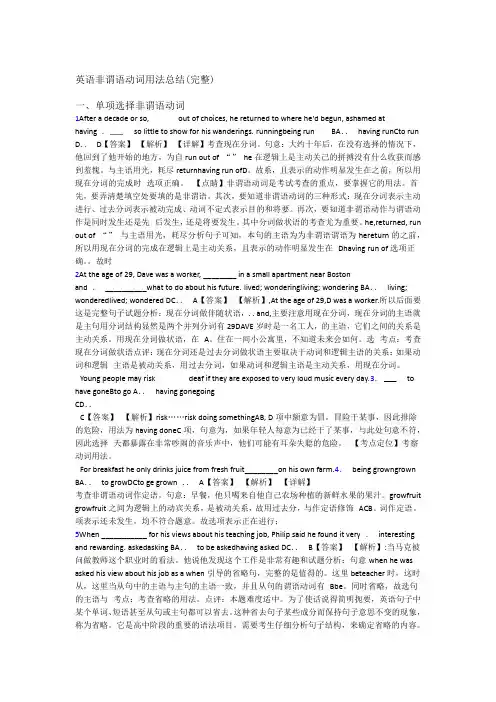
英语非谓语动词用法总结(完整)一、单项选择非谓语动词1After a decade or so, out of choices, he returned to where he'd begun, ashamed athaving .so little to show for his wanderings.runningbeing run BA..having runCto run D..D【答案】【解析】【详解】考查现在分词。
句意:大约十年后,在没有选择的情况下,他回到了他开始的地方,为自run out of “”he在逻辑上是主动关己的拼搏没有什么收获而感到羞愧。
与主语用光,耗尽returnhaving run ofD。
故系,且表示的动作明显发生在之前,所以用现在分词的完成时选项正确。
【点睛】非谓语动词是考试考查的重点,要掌握它的用法。
首先,要弄清楚填空处要填的是非谓语。
其次,要知道非谓语动词的三种形式:现在分词表示主动进行、过去分词表示被动完成、动词不定式表示目的和将要。
再次,要知道非谓语动作与谓语动作是同时发生还是先后发生,还是将要发生。
其中分词做状语的考查尤为重要。
he,returned, run out of “”与主语用光,耗尽分析句子可知,本句的主语为为非谓语谓语为hereturn的之前,所以用现在分词的完成在逻辑上是主动关系,且表示的动作明显发生在Dhaving run of选项正确。
故时2At the age of 29, Dave was a worker, ________ in a small apartment near Bostonand .__________what to do about his future.lived; wonderingliving; wondering BA..living; wonderedlived; wondered DC..A【答案】【解析】,At the age of 29,D was a worker.所以后面要这是完整句子试题分析:现在分词做伴随状语,. . and,主要注意用现在分词,现在分词的主语就是主句用分词结构显然是两个并列分词有29DAVE岁时是一名工人,的主语,它们之间的关系是主动关系。
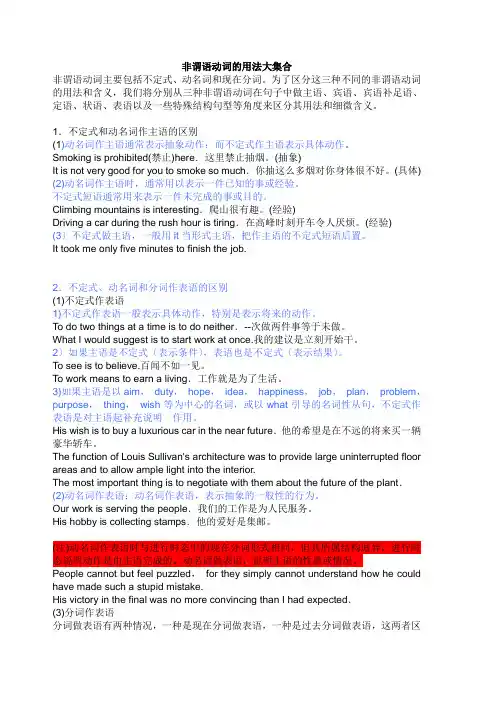
非谓语动词的用法大集合非谓语动词主要包括不定式、动名词和现在分词。
为了区分这三种不同的非谓语动词的用法和含义,我们将分别从三种非谓语动词在句子中做主语、宾语、宾语补足语、定语、状语、表语以及一些特殊结构句型等角度来区分其用法和细微含义。
1.不定式和动名词作主语的区别(1)动名词作主语通常表示抽象动作;而不定式作主语表示具体动作。
Smoking is prohibited(禁止)here.这里禁止抽烟。
(抽象)It is not very good for you to smoke so much.你抽这么多烟对你身体很不好。
(具体) (2)动名词作主语时,通常用以表示一件已知的事或经验。
不定式短语通常用来表示一件未完成的事或目的。
Climbing mountains is interesting.爬山很有趣。
(经验)Driving a car during the rush hour is tiring.在高峰时刻开车令人厌烦。
(经验)(3〕不定式做主语,一般用it当形式主语,把作主语的不定式短语后置。
It took me only five minutes to finish the job.2.不定式、动名词和分词作表语的区别(1)不定式作表语1)不定式作表语一般表示具体动作,特别是表示将来的动作。
To do two things at a time is to do neither.--次做两件事等于未做。
What I would suggest is to start work at once.我的建议是立刻开始干。
2〕如果主语是不定式〔表示条件〕,表语也是不定式〔表示结果〕。
To see is to believe.百闻不如一见。
To work means to earn a living.工作就是为了生活。
3)如果主语是以aim,duty,hope,idea,happiness,job,plan,problem,purpose,thing,wish等为中心的名词,或以what引导的名词性从句,不定式作表语是对主语起补充说明作用。
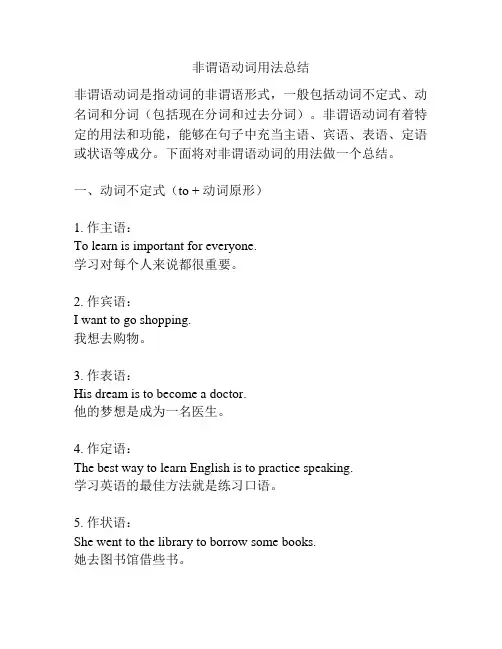
非谓语动词用法总结非谓语动词是指动词的非谓语形式,一般包括动词不定式、动名词和分词(包括现在分词和过去分词)。
非谓语动词有着特定的用法和功能,能够在句子中充当主语、宾语、表语、定语或状语等成分。
下面将对非谓语动词的用法做一个总结。
一、动词不定式(to + 动词原形)1. 作主语:To learn is important for everyone.学习对每个人来说都很重要。
2. 作宾语:I want to go shopping.我想去购物。
3. 作表语:His dream is to become a doctor.他的梦想是成为一名医生。
4. 作定语:The best way to learn English is to practice speaking.学习英语的最佳方法就是练习口语。
5. 作状语:She went to the library to borrow some books.她去图书馆借些书。
二、动名词(Ving形式)1. 作主语:Swimming is good for health.游泳对健康有好处。
2. 作宾语:I enjoy reading novels in my free time.我喜欢在空闲时间读小说。
3. 作表语:Her favorite hobby is drawing.她最喜欢的爱好是画画。
4. 作定语:I saw a man reading a newspaper in the park.我看到一个在公园里读报纸的人。
5. 作状语:She improved her English by practicing every day.她通过每天练习提高了她的英语。
三、分词(普通形式:Ving形式或者过去分词形式)1. 作定语:The smiling girl is my sister.那个笑着的女孩是我的妹妹。
2. 作补语:I saw him running in the race.我看到他在比赛中奔跑。
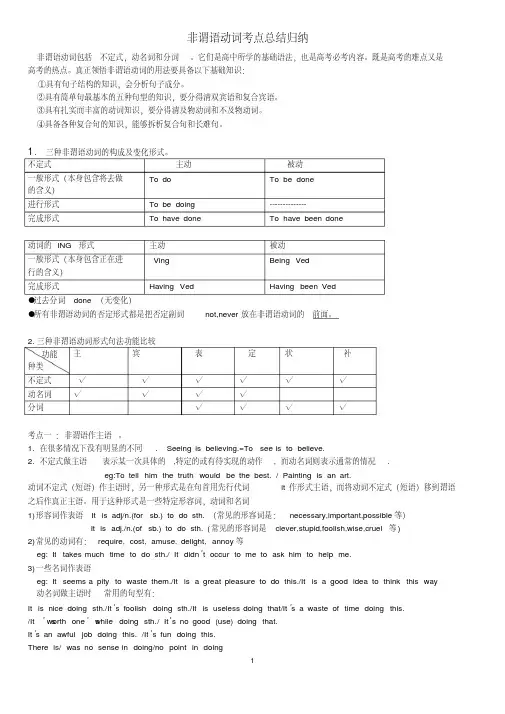
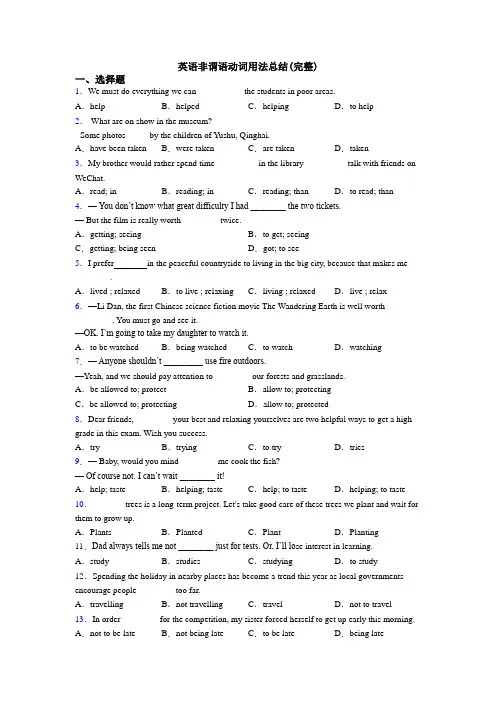
英语非谓语动词用法总结(完整)一、选择题1.We must do everything we can __________ the students in poor areas.A.help B.helped C.helping D.to help2.-What are on show in the museum?-Some photos _____by the children of Yushu, Qinghai.A.have been taken B.were taken C.are taken D.taken3.My brother would rather spend time _________ in the library _________ talk with friends on WeChat.A.read; in B.reading; in C.reading; than D.to read; than 4.—You don’t know what great difficulty I had ________ the two tickets.— But the film is really worth ________ twice.A.getting; seeing B.to get; seeingC.getting; being seen D.got; to see5.I prefer in the peaceful countryside to living in the big city, because that makes me ________.A.lived ; relaxed B.to live ; relaxing C.living ; relaxed D.live ; relax 6.—Li Dan, the first Chinese science fiction movie The Wandering Earth is well worth________ . You must go and see it.—OK. I’m going to take my daughter to watch it.A.to be watched B.being watched C.to watch D.watching 7.—Anyone shouldn’t _________ use fire outdoors.—Yeah, and we should pay attention to ________ our forests and grasslands.A.be allowed to; protect B.allow to; protectingC.be allowed to; protecting D.allow to; protected8.Dear friends, ________ your best and relaxing yourselves are two helpful ways to get a high grade in this exam. Wish you success.A.try B.trying C.to try D.tries9.— Baby, would you mind ________ me cook the fish?—Of course not. I can’t wait ________ it!A.help; taste B.helping; taste C.help; to taste D.helping; to taste 10._______ trees is a long-term project. Let's take good care of these trees we plant and wait for them to grow up.A.Plants B.Planted C.Plant D.Planting11.Dad always tells me not ________ just for tests. Or, I’ll lo se interest in learning.A.study B.studies C.studying D.to study 12.Spending the holiday in nearby places has become a trend this year as local governments encourage people ________ too far.A.travelling B.not travelling C.travel D.not to travel 13.In order ________ for the competition, my sister forced herself to get up early this morning. A.not to be late B.not being late C.to be late D.being late14.We should encourage our students _____ hard instead of ____ too much time playing games. A.work; spend B.to work; spendC.work; spending D.to work; spending15.Online short video apps like Douyin make________easier to do some shopping at home. A.it B.one C.this D.that 16.—What’s your plan for the coming summer holiday?—I’ll devote as much time as I can some v oluntary work.A.to do B.to doing C.do D.doing17.Fans all over the country are talking about ________ this football team has never won any match and ________ to do with it.A.whether; how B.why; how C.whether; what D.why; what18.-How do you feel after watching the movie Amazing, My Country?-Well, I think it is lucky for us ____________ this great country.A.to live B.to live in C.living D.living in 19.—Mother’s Day is coming. Shall we make some paper roses for Mum?—Sounds great! But would you please show me _______ as I know little about DIY? A.where B.why C.whether D.how20.Life is about waiting for the right moment ________, because everyone is in his own TIME ZONE.A.acting B.to act C.act D.acts21.More TV programs, according to government officials, will be produced _____ people’s attention over food safety.A.to raise B.raising C.to rise D.rising22.I was tired out, so I stopped the car a short rest.A.have B.having C.to have D.had23.—I don’t know _____ remember the new English words.—Don’t worry! Try thinking about their pronunciations.A.what to B.how to C.where to D.when to24.–Your robot has caught a virus and it no longer works properly.–Wow, ______ mess it has made! I really don’t know _______ to do with it.A.what, how B.how, how C.what a, what D.how, what 25.My uncle made up his mind to devote his life pollution happily.A.to prevent; to live B.to prevent; from livingC.to preventing; to live D.to preventing; from living26.___________for his good skill, this doctor has a lot of visitors calling for help all the time. A.Knowing B.To know C.Known D.To have known 27.The old couple often take a walk after supper in the park with their pet dog ___________ them.A.to follow B.following C.followed D.follows 28.Mrs. White showed her student some old maps ________from the library.A.to borrow B.to be borrowed C.borrowed D.borrowing 29.—My bike is broken.—Why not have it________?A.repair B.repaired C.repairing D.to repair 30.—Why do the students need to read every day?—________information for writing.A.To collect B.Collecting C.Collect D.Collected 31.—Mum, my computer doesn’t work. It needs_________ .—OK. I will have it _________.A.repairing; repaired B.to repair; repairC.be repaired; repairing D.being repaired; to repair32.What a terrible thing! There is a ________ dog ________ on the ground.A.die, lie B.dead, lying C.death, lay D.dying, lie 33.Seeing their teacher _______ into the classroom, they stopped _______ at once. A.walk; telling B.entering; to speak C.enter; to tell D.walking; talking 34.—What makes you so brave to volunteer in the community?—Because I know that there must be so many people __________ for our support.A.to wait B.wait C.waiting D.waited 35.With a lot of students about too much homework, our teachers have tried some ways to solve this problem.A.complain B.complaining C.complained D.to complain 36.Snakes don’t have ears but they can feel things ________.A.moving B.move C.moved D.to move37.---Is Jack in the next room ?---It’s hard to sa y. But I heard him _____ loudly when I passed by just now.A.speak B.to speak C.spoken D.speaking 38.—What are you talking about?—Some pictures ________ yesterday.A.were taken B.took C.taken D.have been taken 39.—Tom, have you ever read the book A Tale of Two Cities ________ by Charles Dickens?—Yes, I finished reading it last winter vacation.A.wrote B.to write C.writing D.written 40.When I got back home I saw a note on the door ____ “Sorry to miss you; will call later.”A.say B.says C.to say D.saying41.Look! There _______ so many people _________here. Do you know what has happened? A.is, standing B.are, are standing C.are, standing 42.Lily’s parents always encourage her ____out her opinions.A.speak B.speaking C.to speak D.spoken 43.The rubbish ________ every day is becoming a serious problem in cities around the world. A.produce B.produced C.producer D.producing44.--- Have you seen the movie《Lost in Thailand》?--- Yeah, it’s truly worth ________. It’s ________ interesting that I’ve seen it tw ice. A.seeing; too B.to see; enough C.seeing; so D.to see; such45.This food is cooked by a cook _____ Victor.A.call B.calls C.called D.calling 46.Gina is the only girl ______ a coat.A.who wear B.who wearing C.wearing D.wears47.I would rather spend time ______ at home than ______ out with you.A.staying; go B.to stay; to go C.staying; to go D.to stay; go48.—Spring is also the time when the farmers are busy _______ the wheat.—Usually they don’t stop _______ even it’s lunchtime.A.growing; working B.growing; to work C.grow, to work D.grow; working 49.People are advised to avoid ________ their eyes, nose, and mouth with unwashed hands. A.touch B.touched C.to touch D.touching 50.Paul is really considering________himself to________ those children in the earthquake-hit area.A.to devote, teaching B.devoting, teaching C.devoting, teach D.to devote, teach 51.—I prefer ________ with a pen to ________ on the computer, because I type so slowly. —So do I.A.write; typing B.to write; to type C.writing; to type D.writing; typing 52.These young trees will require ________carefully.A.to look after B.being looked after C.having looked after D. looking after 53.Huawei has succeeded in ________new software for his products. I can’t wait ________a new Huawei mobile.A.developing, to buy B.developed, buying C.developing, buy D.develop, buying 54.—How much do you know "996" schedule?—Well, it means _____________from 9 am to 9 pm, six days a week.A.working B.worked C.to work D.works 55.When you travel abroad, you can hardly avoid products made in China.A.to buy B.buy C.buying D.be bought56.A new high-speed railway ________ Yangzhou ________ Nanjing will be built. A.connected; and B.connects; with C.connected; to D.connecting; to 57.I like because it makes us know ourselves better and know more about the world. A.reading B.cooking C.swimming D.dancing58.The girl is often seen ____in the art room.A.practice drawing B.practised drawingC.to practice drawing D.practice to draw59.--Would you mind basketball here? I'm writing a report.--Sorry. We'll go and play it on the playground.A.playing B.not playing C.to play D.not to play60.If you want to make yourself ______, you should speak clearly and slowly.A.to understand B.understood C.understand D.understanding 【参考答案】一、选择题1.D解析:D【详解】句意:我们必须尽我们所能来帮助贫困地区的学生。
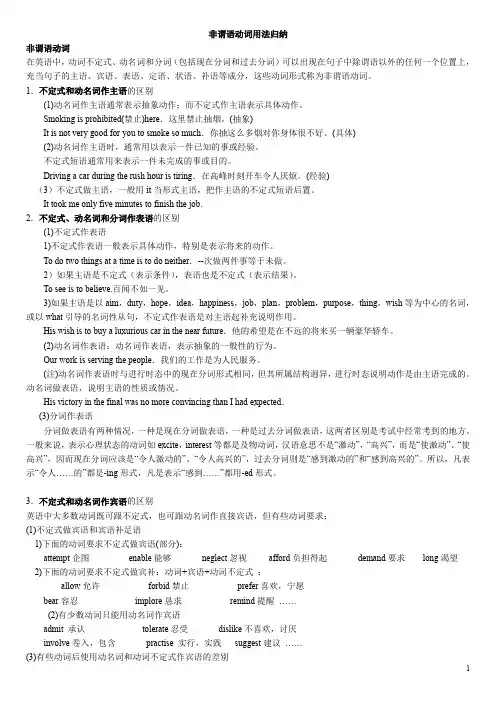
非谓语动词用法归纳非谓语动词在英语中,动词不定式、动名词和分词(包括现在分词和过去分词)可以出现在句子中除谓语以外的任何一个位置上,充当句子的主语、宾语、表语、定语、状语、补语等成分,这些动词形式称为非谓语动词。
1.不定式和动名词作主语的区别(1)动名词作主语通常表示抽象动作;而不定式作主语表示具体动作。
Smoking is prohibited(禁止)here.这里禁止抽烟。
(抽象)It is not very good for you to smoke so much.你抽这么多烟对你身体很不好。
(具体)(2)动名词作主语时,通常用以表示一件已知的事或经验。
不定式短语通常用来表示一件未完成的事或目的。
Driving a car during the rush hour is tiring.在高峰时刻开车令人厌烦。
(经验)(3)不定式做主语,一般用it当形式主语,把作主语的不定式短语后置。
It took me only five minutes to finish the job.2.不定式、动名词和分词作表语的区别(1)不定式作表语1)不定式作表语一般表示具体动作,特别是表示将来的动作。
To do two things at a time is to do neither.--次做两件事等于未做。
2)如果主语是不定式(表示条件),表语也是不定式(表示结果)。
To see is to believe.百闻不如一见。
3)如果主语是以aim,duty,hope,idea,happiness,job,plan,problem,purpose,thing,wish等为中心的名词,或以what引导的名词性从句,不定式作表语是对主语起补充说明作用。
His wish is to buy a luxurious car in the near future.他的希望是在不远的将来买一辆豪华轿车。
(2)动名词作表语:动名词作表语,表示抽象的一般性的行为。

非谓语动词用法总结非谓语动词主要包括不定式、动名词和现在分词。
为了区分这三种不同的非谓语动词的用法和含义,我们将分别从三种非谓语动词在句子中做主语、宾语、宾语补足语、定语、状语、表语以及一些特殊结构句型等角度来区分其用法和细微含义。
接下来,小编给大家准备了非谓语动词用法总结,欢迎大家参考与借鉴。
非谓语动词用法总结1.不定式和动名词作主语的区别(1)动名词作主语通常表示抽象动作;而不定式作主语表示具体动作。
Smoking is prohibited(禁止)here.这里禁止抽烟。
(抽象)It is not very good for you to smoke so much.你抽这么多烟对你身体很不好。
(具体)(2)动名词作主语时,通常用以表示一件已知的事或经验。
不定式短语通常用来表示一件未完成的事或目的。
Climbing mountains is interesting.爬山很有趣。
(经验)Driving a car during the rush hour is tiring.在高峰时刻开车令人厌烦。
(经验)(3)不定式做主语,一般用it当形式主语,把作主语的不定式短语后置。
It took me only five minutes to finish the job.2.不定式、动名词和分词作表语的区别(1)不定式作表语1)不定式作表语一般表示具体动作,特别是表示将来的动作。
To do two things at a time is to do neither.--次做两件事等于未做。
What I would suggest is to start work at once.我的建议是立刻开始干。
2)如果主语是不定式(表示条件),表语也是不定式(表示结果)。
To see is to believe.百闻不如一见。
To work means to earn a living.工作就是为了生活。
3)如果主语是以aim, duty, hope, idea, happiness, job,plan,problem,purpose,thing,wish等为中心的名词,或以what引导的名词性从句,不定式作表语是对主语起补充说明作用。
(完整版word)非谓语动词用法总结及解析一、非谓语动词1.——Grandpa has changed a lot.——So he has. He spends more time than he used to ______ games with the children.A. playB. playingC. playedD. plays【答案】 B【解析】【分析】句意:——爷爷变了很多。
——他确实如此。
他玩游戏比过去用的时间多了。
spend用于sb spend...on sth或者sb spend...in doing sth(in可以省略),spend的主语必须是人,可以指花费时间、也可以指花费金钱。
本句中he used to后面省略了动词spend,故选B。
【点评】考查非谓语动词2.When you are tired, in the countryside is a wonderful experience.A. relaxingB. relaxedC. relaxD. relaxes【答案】 A【解析】【分析】考查非谓语动词。
句意:当你累的时候,在农村放松是一个奇妙的体验。
所填动词在句中作主语,该用动名词形式,所以选A。
3.As we all know, a person learns many things by making mistakes and ________ them.A. correctsB. correctC. to correctD. correcting【答案】 D【解析】【分析】句意:正如我们所知,一个人通过犯错误和纠正错误中,能学会很多东西。
and,表并列的连词,前后动词用法应该一致,根据making,可知此处用动词ing形式,因此用correcting,故选D。
【点评】考查固定搭配。
注意介词后接动词的ing形式。
4.The policeman warned the man after drinking.A. not to driveB. to driveC. driving【答案】 A【解析】【分析】句意:警察警告那个男人不要酒后驾驶。
英语非谓语动词用法总结(完整)一、单项选择非谓语动词1.After a decade or so, out of choices, he returned to where he’d begun, ashamed at having so little to show for his wanderings.A.being run B.runningC.to run D.having run【答案】D【解析】【详解】考查现在分词。
句意:大约十年后,在没有选择的情况下,他回到了他开始的地方,为自己的拼搏没有什么收获而感到羞愧。
run out of “用光,耗尽” 与主语he在逻辑上是主动关系,且表示的动作明显发生在return之前,所以用现在分词的完成时having run of。
故D 选项正确。
【点睛】非谓语动词是考试考查的重点,要掌握它的用法。
首先,要弄清楚填空处要填的是非谓语。
其次,要知道非谓语动词的三种形式:现在分词表示主动进行、过去分词表示被动完成、动词不定式表示目的和将要。
再次,要知道非谓语动作与谓语动作是同时发生还是先后发生,还是将要发生。
其中分词做状语的考查尤为重要。
分析句子可知,本句的主语为he,谓语为returned, run out of “用光,耗尽”为非谓语与主语he在逻辑上是主动关系,且表示的动作明显发生在return的之前,所以用现在分词的完成时having run of。
故D选项正确。
2.At the age of 29, Dave was a worker, ________ in a small apartment near Boston and__________what to do about his future.A.living; wondering B.lived; wonderingC.lived; wondered D.living; wondered【答案】A【解析】试题分析:现在分词做伴随状语,At the age of 29,D was a worker.这是完整句子,所以后面要用分词结构. 有and,显然是两个并列分词. 主要注意用现在分词,现在分词的主语就是主句的主语,它们之间的关系是主动关系。
英语非谓语动词用法总结(完整)一、单项选择非谓语动词1. that it was going to rain, James took a raincoat with him.A.Seeing B.SawC.Seen D.To see【答案】A【解析】考查非谓语动词。
句意:看到即将下雨,James随身带着雨衣。
分析句子可知,“see that it was going to rain”作状语,see与主语James是主动关系,用现在分词表示主动关系。
故选A。
2. Hours of playing violent video games can affect the way the brain works, ______ damage to certain cells of brain.A.to cause B.cause C.causing D.caused【答案】C【解析】试题分析:考查非谓语动词。
causing 现在分词作结果状语。
句意:连续几个小时打暴力的电子游戏会影响大脑的工作方式,危害大脑细胞并减慢大脑的活动。
故C正确。
考点:考查非谓语动词3.115.______ his love, Chris sent his mom a thank-you note on Mother’s Day. A.Expressing B.Expressed C.To express D.Having expressed【答案】C【解析】考查动词不定式。
句意:为了表达他的爱,克里斯在母亲节那天给他的妈妈寄了一条感谢信。
用不定式表目的,故选C。
4.Shortly after suffering from a massive earthquake and ________ to ruins, the city took on a new look.A.reducing B.reduced C.being reduced D.having reduced 【答案】C【解析】【详解】考查动名词的被动语态。
非谓语动词的用法总结李靖非谓语动词(不定式、动名词、分词)不是真正意义上的谓语动词,在句中都不能单独作谓语。
但都具有动词的某些特点,可以有自己的宾语或状语,构成非谓语动词短语。
不定式表目的,表将来;动名词表主动,表进行;过去分词表被动,表完成。
一.作主语( 动名词、不定式、过去分词前面加being, 动名词做主语谓语动词用单数)1)不定式、动名词都可做主语,但是动名词做主语多指抽象的概念性的动作,可以是多次的经常的行为;不定式多表示具体的动作,尤其是某一次的动作。
如:Playing with fire is dangerous. 玩火危险。
(泛指玩火)To play with fire will be dangerous. 玩火会发生危险。
2)用动名词做主语的句型:It’s no use/no good/pleasure doing sth 做。
.。
.没有用处/好处/乐趣It’s a waste of time doing sth 做。
.。
浪费时间It is worth doing sth 值得做某事It is no use crying over spilt milk. 覆水难收It is worth making an appointment before you go. 去之前预约一下是值得的。
3)不定式做主语的句型.It is + adj +for sb to do sth.比较:表示人的品质时只能用of sb 如considerate/kind/nice/foolish/stupid/rude/cruel /wise/clever/brave/selfish/crazy/good/careful/careless/impolite/right/wrong等单词出现时。
It is silly of you to say so。
It is important for us to learn English well.It is a must/ a necessity for us to have a good command of the English language.4) “Wh- + to 不定式”可做主语。
非谓语动词总结(高考完整版)一、非谓语动词的含义非谓语动词首先是一种动词形式,其次是这种动词形式不能做谓语,综合这两点,我们将其叫做非谓语动词。
老师进来时,她假装正在读书。
④完成时:to have done(表示主动和完成)eg: The thief is said to have escaped.据说小偷已经逃跑了。
⑤完成被动式:to have been done(表示被动和完成)eg:The thief is said to have been arrested.据说小偷已经被抓住了。
⑥完成进行式:to have been doing (表示主动和完成进行)eg: She is said to have been working in the factory over the last 20 years.据说在过去的20年里,她一直在这家工厂工作。
(2)动名词①基本形式:doing (表示主动)eg: Travelling in space by ordinary people will be common in the future.在未来,普通人在太空旅行将会是普遍的事情。
②被动式:being done(表示被动)eg: Freddy and his band could go nowhere without being followed by their fans.弗雷迪和他的乐队到哪里都被他们的粉丝跟着。
③完成式:having done(表示主动和完成)eg: I have no idea of his having done such a thing against you.我不知道他做过这样一件违背你的事情。
④完成被动式:having been done(表示被动和完成)eg: Many customers complain of having been given short weight at that shop.很多顾客抱怨在那家商店被缺斤少两过。
非谓语动词的用法总结一、非谓语动词概述非谓语动词是指不具备谓语性质的动词形式,它以独立于主谓结构的方式出现在句子中。
在英语中,非谓语动词包括不定式、现在分词和过去分词。
本文将总结非谓语动词的用法,并重点讨论其作为状语、定语和补足语的功能。
二、不定式的用法1. 作为目的状语:不定式常用来表示动作或状态的目的。
例如:“I went to the store to buy some groceries.”(我去商店买些杂货)2. 作为结果状语:不定式有时表示某个动作或状态发生的结果。
例如:“He worked hard to climb the mountain.”(他努力工作才成功登上山顶)3. 作为原因状语:不定式可以用来表示某个行为或状态发生的原因。
例如:“She stayed up late to finish her homework.”(她熬夜完成家庭作业)4. 作为条件状语:在条件句中,常使用"if"引导一个带有不定式的从句。
例如:“If you want to succeed, you must work hard.”(如果你想成功,就必须努力工作)5. 作为名词性质:不定式可以充当名词的角色,用来作主语、宾语、表语等。
例如:“To travel is my dream.”(旅行是我的梦想)6. 作为定语:不定式可以修饰名词或代词,起到定语的作用。
例如:“Thebook to read is on the shelf.”(要读的那本书在书架上)三、现在分词的用法1. 作为形容词:现在分词可用于描述一个正在进行或具有某种性质的人或事物。
例如:“She saw a crying baby in the park.”(她看到了公园里哭泣的婴儿)2. 作为状语:现在分词可以表示时间,原因,条件等意义。
例如:“Walking by the river, he felt relaxed.”(边走边看河流,他觉得很放松)3. 和系动词连用:现在分词可以和系动词连用,构成谓语部分。
非谓语动词用法总结非谓语动词是历年高考英语的重要考点之一,同时也是较难掌握的难点之一。
它贯穿于英语学习和考试过程的始终。
但是,只要认真分析、透彻理解、看透本质、准确把握,就一定能在高考中运筹帷幄,游刃有余。
一.非谓语动词区别简表二.不定式的用法不定式不可作谓语,但它可以有自己的宾语、状语,构成不定式短语,在句中可以作主语、宾语、表语、定语(表用途)、状语或补足语。
高考对不定式的考查主要有不定式的时态、语态、作用、否定、省略、连词+不定式等。
作主语不定式作主语表示具体的动作,通常指一件已知的事或目的。
不定式作主语时,谓语动词用单数。
eg:To say is a thing,to do is another.(说是一回事,做是另外一回事。
)(2)不定式短语较长时,通常放在谓语之后,用it作形式主语。
eg:①It is important to learn English well.(学好英语是重要的。
)②It is necessary for us to do the job well.(我们做好这项工作是必要的。
)③It is a great honor to be invited to give a speech here.(被邀请在这儿发表演讲是一个极大的荣幸。
)2.作宾语(1)常只用不定式作宾语的动词有:want,wish,hope,long,expect,desire,intend ,decide,ask,promise,aim,offer,agree,plan,l earn,choose,refuse,fail,manage,pretend 等。
eg:①He refused to help me.(他拒绝帮助我.)②She has agreed to cometomorrow.(他已同意明天来.)(2) 不定式较长时,作宾语,也可用it代替,放在后面。
eg;I find it difficult to do the job well.(3) “特殊疑问词﹢不定式to do结构”具有名词特征,可作宾语。
eg:①She didn’t know whether to go or not.②They haven’t decided when and where to build the school.(4)不定式可作介but,except,besides(除……之外)的宾语,介词前有实义动词do的任何一种形式,后边的不定式就无to,否则必带to。
eg:①I want to do nothing but play the computer games。
②I have no choice but to wait。
3.动词不定式作表语(1)不定式作表语放在be和其他系动词后,说明主语的内容。
同样,“特殊疑问词+不定式”具有名词特征,也可作表语。
eg:①My job is to sweep the floor.②His goal was to enter the key university of Beijing.③The first question is how to find a better way to learn English well.(2)不定式作主语时,表语也必须为不定式,结构必须保持一致。
eg:To see is to believe.(3)如果主语部分的谓语动词或非谓语动词是实义动词do的某种形式,那么作表语的不定式可以省去to.eg:①The first thing to do is find her.②The only thing he could do was tell the truth.4.不定式作定语不定式作定语常放在所修饰的名词或代词后。
eg:①I have something important to tell you.(不定式与被修饰名词构成被动关系。
)②His wish to an artist has never cometrue.( 不定式与被修饰名词构成同位关系。
)He is the right man to do the job. ( 不定式与被修饰名词构成主动关系。
)The little girl was unhappy because she had no friends toplay with. ( 不定式与被修饰名词构成主动关系。
)(注:若不定式为不及物动词,其后须加上相应的介词。
)5.不定式作状语不定式作状语主要是表示目的、条件、原因和结果,可位于句首或句末,但句首时通常用逗号隔开。
eg:①We set off early that morning to catch the first bus.(目的)②To get a good result,she worked very hard.(目的)③I feel it an honor to be invited to the party.(条件)④She was very happy to get the first prize.(原因)⑤He worked hard only to fail.(结果) (注:1.不定式常用在so as 或in order后,与它们一起作谓语,表示目的,但so as引起的不定式不可置于句首。
eg:In order to avoid mistakes,check your homework.2.不定式表目的常和only连用,往往表示出乎意料的意想不到的不愿得到的结果。
eg:He hurried to the station only to find the train had left.)3.“形容词+enough+不定式”和“too+形容词或副词(不表情感)+不定式”也可作结果状语。
eg:①He is old enough to go to school.②He is too weak to raise the stone.但“too+表情感形容词(pleased,ready,glad,willing,anxious等)+to do”表示肯定意义,too前面可用only,but等词修饰。
eg:①They were (only) too anxious to leave.(他们只是太急于离开了。
)②She is (only) too pleased to go home.(她非常高兴可以回家了。
)6.不定式作补语不定式作补语表示动作的完成。
宾语与作补语的不定式之间是主动关系。
(1)后接动词不定式作宾补的常见动词有:want,wish,expect,prefer,like,hate,ask,beg, request,require,beg,get,advise,persuade,i nvite,order,remind,permit,allow,send,call on,wouldlike/love,arrange for,depend on 等。
eg:①She wanted me to arrive there early.②Our headmaster call on us to work hard.(2)动词不定式可作感官动词(五看二听一感觉即:see,look at,watch,observe,notice,hear,listen to,feel)和使让动词(let,make,have等)后面的宾补时,不定式符号to要省略,但如果句子变被动结构,必须带to.表示动作的完成。
eg:①He made them climb the hill.②They were made to climb the hill.(3)动词不定式可作形容词的补足语动词不定式可作形容词的补足语,句型为:(一)主语+系动词+表语(adj为convenient/easy/expensive/difficult/hard /impossible/pleasent等)+to do.(注:to do 常用主动表被动,其中do为vt,主语为to do 的宾语。
)(二)主语+find/think/consider/believe等+宾语+adj+to do.(注:其中to do常用主动表被动,其中do为vt,主语为to do的宾语。
) eg:①He is easy to fool.②Thewomanishardtoworkwith.③Hefindthejobdifficulttodo.(4)“特殊疑问词+不定式to do”具有名词特征,可作宾补。
(谓语动词多为show,know,teach,tell等。
)eg:I’ll tell you how to get there7不定式作评注性状语或插入语不定式可以作评注性状语或插入语,放在句子前面、中间或末尾。
常见的有to be frank,to be honest,to tell the truth,to begin with,to start with,to be short等。
eg:To begin with,I thinkyou are wrong. 三.动名词用法动名词具有动词和名词的特点,有一般式和完成式,有主动式和被动式,可作主语、宾语、表语和定语.否定形式在其前面加not.(1)动名词作主语动名词作主语表示抽象动作,指一件已知的事或经验。
eg:①Driving a car on the crowded road is boring.②Reading is my hobby.(2)常只用动名词作宾语的动词有:admit,avoid,appreciate,consider(考虑)dislike,enjoy,escape,excuse,finish,imagine ,keep,mind,miss,practise,risk,resist,sugge st等。
eg:①I can’t imagine marrying her.②She managed to escape being punished.以下动词词组后面只接动名词作宾语:give up,belong to,look forward to,keepon,insist on,be busy,get down to,be devoted to,havedifficulty/trouble(in),haveagood/wonderful time (in)等。
eg:①I’m looking forward to hearing from you soon.②He gave up smoking three years.(3)动名词可作表语动名词可作表语,一般为主语的内容.表示一般性或习惯性的动作。